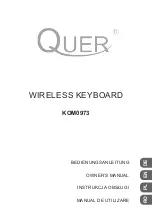
3
1.0 ELECTRRICAL
1.1 Power
1.1.1 5VDC
±
10%, 40mA .
2.0 POWER ON ROUTINE
2.1 Power on Reset-POR-
2.2.1 The keyboard will perform a power on reset -POR- within a minimum of
150
㎳
and a maximum of 2
㎳
.
2.2 Basic Assurance Test -BAT-
2.2.1 The keyboard will conduct a basic assurance test -BAT- of the processor.
2.2.2 Turn the LED's(if so equipped) on at the beginning of the test and off at
the end of the test.
2.2.3 Transmit the completion code AAH if the test was successful.
2.2.4 The -BAT- takes a maximum of 500
㎳
. During this time all activity on the
clock and data lines will be ignored.
2.2.5 The completion code will be transmitted within 450
㎳
and not more than
2.5sec after -POR-, and within 500
㎳
after a reset command is acknowledge.
3.0 DATA TRANSMISSION
3.1 Clock and Data lines
3.1.1 The click and data lines are used for communication in both directions
between the system and the keyboard. These lines are driven by an open
collector device which allows either the system or the keyboard to force the
line to an inactive(low)level. When no communication is occurring both lines
are active(high).
3.1.2 The keyboard provides the clocking signals used to clock serial data to and
from the keyboard.
3.1.3 The data line is used for transmission of data by both the system and the
keyboard. The system issues a`Request to Send' -RTS- by pulling the data line
to logic`0'.
3.2 DATA format
3.2.1 The data protocol is an 11-bit data stream that consists of 1 start
bit(always Logic 0), 8 data bits(least significant bit to most significant bit
respectively), 1 odd parity bit, and 1 stop bit(always Logic 1).
3.2.2 See figure 14 for graphic representation of these signals.
3.3 Keyboard to System line protocol
3.3.1 Keyboard checks clock line, if Logic 1 continue, if Logic 0 store keystrokes
if protocol is 11-bit(inhibited); otherwise check for possible reset.
3.3.2 Keyboard checks data line, if Logic 1 continue, if Logic 0 prepare to receive
data from system if protocol is 11-bit; otherwise store keystrokes(inhibited).
3.3.3 Keyboard transmits data. While transmitting in the 11-bit protocol, the
keyboard checks the clock line for logic level 1 at least every 60
㎲
.(See line
contention below).
3.4 Line Contention
3.4.1 The system may interrupt keyboard data transmission at any time up to the
10th clock by pulling the system must receive the keyboard data.
3.5 Line Contention
3.5.1 System inhibits keyboard by lowering clock line to logic 0 for a minimum of
60
㎲
.
3.5.2 System requests transmission by lowering the data to logic 0(-RTS-)and
allows the clock line to go active.
Summary of Contents for SKR-2006
Page 1: ...1 User s Manual SKR 2006 Sejin Electron Inc ...
Page 9: ...9 ...



























